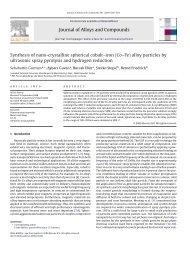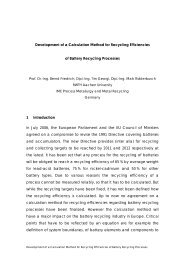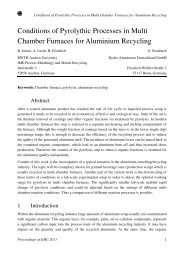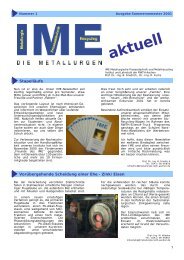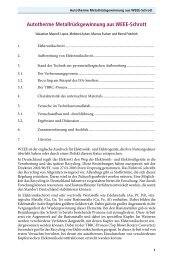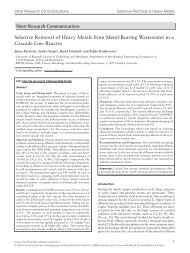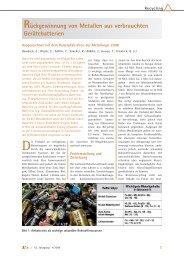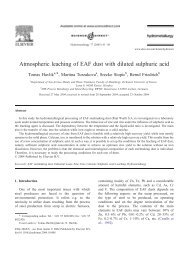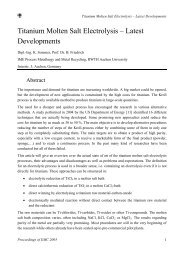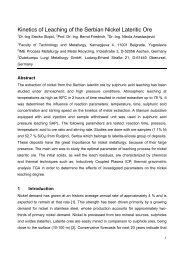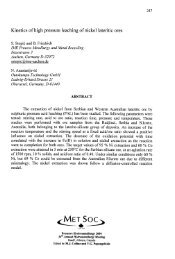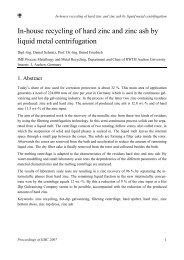Recycling of gamma titanium aluminide scrap from investment ...
Recycling of gamma titanium aluminide scrap from investment ...
Recycling of gamma titanium aluminide scrap from investment ...
You also want an ePaper? Increase the reach of your titles
YUMPU automatically turns print PDFs into web optimized ePapers that Google loves.
Intermetallics 19 (2011) 762e768Contents lists available at ScienceDirectIntermetallicsjournal homepage: www.elsevier.com/locate/intermet<strong>Recycling</strong> <strong>of</strong> <strong>gamma</strong> <strong>titanium</strong> <strong>aluminide</strong> <strong>scrap</strong> <strong>from</strong> <strong>investment</strong> casting operationsJ. Reitz a, *, C. Lochbichler b , B. Friedrich aa RWTH Aachen University, IME Process Metallurgy and Metals <strong>Recycling</strong>, Intzestrasse 3, 52056 Aachen, Germanyb Formerly IME, Now Voestalpine Giesserei Traisen GmbH, Mariazellerstrasse 75, A-3160 Traisen, AustriaarticleinfoabstractArticle history:Received 2 November 2010Accepted 15 November 2010Available online 13 December 2010Keywords:A. Titanium <strong>aluminide</strong>s, based on TiAlB. Thermodynamic and thermochemicalpropertiesC. meltingC. casting (including segregation)C. purificationIn <strong>investment</strong> casting processes for TiAl alloys, a substantial amount <strong>of</strong> the original raw material does notend-up as a final product but is instead solidified in runners and feeders <strong>of</strong> the casting system or asa skull in the crucible. Because <strong>of</strong> the high prices for the virgin alloys, there is a strong interest inremelting this <strong>scrap</strong>. This is a challenging task due to the tremendous oxygen affinity <strong>of</strong> <strong>titanium</strong> alloys.The contact <strong>of</strong> the melt with shell mould and crucible material leads to oxygen pickup during casting. Upto now no technique exists to avoid this effect, thus any recycling process for TiAl casting <strong>scrap</strong>potentially needs a deoxidation technique. Within the IMPRESS project, experimental pro<strong>of</strong> for thefeasibility <strong>of</strong> a novel treatment has been obtained in a series <strong>of</strong> tests and results are presented in thispaper. Casting <strong>scrap</strong> <strong>from</strong> pilot-trials has been consolidated via classic vacuum induction melting (VIM)in special ceramic crucibles and then successfully deoxidized by pressure electroslag remelting (PESR)under reactive slags. Further refining by vacuum arc remelting (VAR) finally leads to removal <strong>of</strong> dissolvedreducing agent and impurities like non-metallic-inclusions.Ó 2010 Elsevier Ltd. All rights reserved.1. Introduction1.1. The integrated recycling conceptDue to their good corrosion resistance, their low density andinteresting mechanical properties at high temperatures g-phase<strong>titanium</strong> <strong>aluminide</strong>s are widely regarded as the next generationmaterial for high temperature structural applications in the aerospaceand automotive industry. However the high material andproduction costs for semi-finished products actually slow down anindustrial breakthrough to mass production <strong>of</strong> g-TiAl.From a processing standpoint the material yield in <strong>investment</strong>casting is similar for TiAl as for standard <strong>titanium</strong> alloy casting witha loss in the range <strong>of</strong> 40e60%. On the other hand g-TiAl alloys areproduced at a tremendously higher cost compared to classic <strong>titanium</strong>alloys like Ti-6Al-4 V due to more strict specifications on alloycomposition and homogeneity. This is necessary in order to achievedesired high temperature strength at an acceptable level <strong>of</strong> ductility.Thus material losses during casting <strong>of</strong> g-TiAl should have a moresevere impact on overall product cost than in classical <strong>titanium</strong> alloycasting and hence recycling becomes even more economicallyinteresting for g-TiAl than it is potentially for <strong>titanium</strong>.Since the year 2000 a research group at IME, Aachen aims on costreducedproduction methods for g-TiAl. While one path follows the* Corresponding author. Tel.: þ49 2418095196.E-mail address: jan.reitz@rwth-aachen.de (J. Reitz).alternative aluminothermic production <strong>of</strong> TiAl <strong>from</strong> TiO 2 pigmentand subsequent refining [1,2], parallel activities aim for development<strong>of</strong> an efficient process for recycling TiAl-<strong>scrap</strong> <strong>from</strong> castingoperations in order to avoid the present downgrading <strong>of</strong> this valuablematerial as an alloying element in the steel industry.In IME’s integrated concept (see Fig. 1), which includes bothalternative primary production and recycling, the first melting <strong>of</strong>a <strong>scrap</strong> charge is done by conventional vacuum induction melting(VIM) using specialised ceramic lining. This step can includepreliminary deoxidation by injection <strong>of</strong> calcium metal into the melt[3]. Full deoxidation and reactive refining follows during pressureelectroslag remelting (PESR) using a continuously re-activatedcalcium-metal-containing slag. During final vacuum arc remelting(VAR) micron size slag inclusions as well as dissolved calcium andhydrogen can be removed. For each processing step special equipmentrequirements and metallurgical challenges have to be met andthe different refining opportunities need to be exploited to obtaina sound recycled TiAl ingot. This paper presents the latest progress<strong>of</strong> the work with a special focus on oxygen removal, refining andhomogenisation by PESR. Final VAR melting is presently underinvestigation and results shall be presented in a second publication.1.2. Introduction to electroslag remelting (ESR)ESR is widely applied in the production <strong>of</strong> speciality steels andsuperalloys nowadays in order to obtain ingots with superior cleanliness,minimized segregation and a homogeneous microstructure.0966-9795/$ e see front matter Ó 2010 Elsevier Ltd. All rights reserved.doi:10.1016/j.intermet.2010.11.015
J. Reitz et al. / Intermetallics 19 (2011) 762e768 763TiAl <strong>scrap</strong>1000-1500 ppm OVIMVIMelectrode,3000 ppm Oalternative productionroute<strong>scrap</strong> routeATR revert,15 000 ppmOPESRPESR ingot,500 ppm O,800 ppm CaVARalternativeTiO 2rawmaterialsAl powderATRATRelectrode,15 000 ppmOVAR ingot500 ppm OFig. 1. Integrated concept for alternative production and recycling <strong>of</strong> TiAl developed atIME, Aachen.As a basic principle the tip <strong>of</strong> a consumable electrode, made <strong>from</strong> thealloy to be refined, is dipped into a molten flux, contained in a watercooledcopper crucible. Electrical currents (most commonly AC) areapplied between the electrode and the flux and result in joule heatingup to the melting point <strong>of</strong> the metal. A liquid metal film forms on thedownside <strong>of</strong> the electrode and hence metal droplets are releasedwhich sink through the flux bath due to the difference in density. Theslag bath floats on a liquid metal pool which collects the droplets.Through cooling at the mould surfaces, solidification occurs and theprocess continuously builds up a refined ingot with a controlledmicrostructure and smooth outer surface.The potentials <strong>of</strong> the application <strong>of</strong> ESR for the remelting <strong>of</strong> pure<strong>titanium</strong> using CaF 2 -based fluxes has been investigated by variousresearchers [4e10] with promising results concerning the possibilityto produce slab-shaped ingots and improvements regardingmaterial yield and energy consumption in comparison to VAR.Results also show interesting possibilities to reduce segregationeffects due lower possible melt rates compared to VAR. Mechanicalproperties <strong>of</strong> ESR remelted c.p. <strong>titanium</strong> are reported to becomparable to VAR melted <strong>titanium</strong> [5], despite an ongoingdiscussion about possible solution <strong>of</strong> fluorine in the metal [11].2. Materials and methods2.1. Characterisation <strong>of</strong> raw materialA first evaluation <strong>of</strong> the process was carried out using spentsputter targets <strong>of</strong> the binary composition Ti50Al as a startingmaterial <strong>of</strong> high purity, low initial oxygen content and avoidingeffects <strong>of</strong> ternary alloying elements. As a second step, <strong>scrap</strong>s<strong>from</strong> casting trials within the IMPRESS project [12] on the alloysTi-46Al8Nb and Ti46Al8Ta were recycled (Fig. 2).In the recycling <strong>of</strong> metallic <strong>scrap</strong>, sampling <strong>of</strong> the input materialplays an important role. Usually <strong>scrap</strong> input comes in batches andrepresentative samples have to be prepared and analysed allowingfor calculation <strong>of</strong> an optimum charge in the crucible. Depending onthe result <strong>of</strong> this, the target composition was adjusted by adding<strong>titanium</strong> sponge, aluminium granules (99.95% purity) and tantalumsheet <strong>scrap</strong>s <strong>from</strong> stamping operations.2.2. Consolidation by VIMMelting trials for consolidation <strong>of</strong> <strong>scrap</strong> and casting <strong>of</strong> electrodeswere carried out using a vacuum induction furnace with a meltcapacity <strong>of</strong> 14 l and a nominal melting power <strong>of</strong> 150 kW. Because <strong>of</strong>the high reactivity <strong>of</strong> TiAl melts towards ceramic crucibles, specialhigh purity CaO crucibles were selected (see Section 3.1). Chemicalanalysis <strong>of</strong> the crucible material reveals very little contamination byother oxides (SiO 2 0.14 wt%, Al 2 O 3 0.07 wt%, Fe 2 O 3 0.05 wt%, MgO0.48 wt%). The crucible volume allowed a charge weight <strong>of</strong>approximately 28 kg depending on the shape <strong>of</strong> the <strong>scrap</strong> materialand the resulting void in the charge (see Fig. 3).Aluminium losses during melting can be easily compensated bycharging a higher Al concentration <strong>from</strong> the start. The evaporationrate <strong>of</strong> Al at our experimental conditions was estimated based onthe experimental findings <strong>of</strong> Guo et al. [13] and extrapolated to theactual crucible diameter <strong>of</strong> 25 cm at an expected holding time <strong>of</strong>Fig. 2. Scrap <strong>from</strong> Ti46Al8Ta and Ti46Al8Nb used in trials.
764J. Reitz et al. / Intermetallics 19 (2011) 762e768Fig. 4. VIM-cast g-TiAl electrode in dismantled copper mould.<strong>of</strong> the process was realised by a specially invented procedure usingspent Ti50Al sputter targets for arc ignition in the slag. After themelting process, the ingot was carefully removed <strong>from</strong> the crucible.Slag samples were taken at positions corresponding to the metalsamples for further investigation <strong>of</strong> slag chemistry and correlationto metal composition.Fig. 3. Heated <strong>scrap</strong> charge prior to melting.4500 s. Composition was adjusted by addition <strong>of</strong> 100 g Al granulesfor the TiAleNb alloy and 310 g Al for the TiAleTa alloy respectively.Furthermore 91 g <strong>of</strong> Ta were added to the latter. The material wascharged into the crucible at room temperature, the furnace wasthen closed, evacuated below 1 10 3 mbar and flushed with argontwice in order to minimize the residual oxygen in the chamber.Melting took place under argon to reduce the evaporation <strong>of</strong>volatile alloying constituents. To avoid thermal shocks in the crucible,melting power was increased in discrete steps every half hour. Afterdetecting the first molten metal, power was kept constant until allmaterial was liquid. The casting temperature was aimed at1650e1700 C depending on the liquidus temperature <strong>of</strong> the targetalloy and measured by immersion thermocouples enclosed ina special casing. The homogeneous melt was cast into a water-cooledcopper mould in order to obtain an electrode (diameter: 108 mm,length: 750 mm) with minimum segregation (Fig. 4).2.4. Sampling and chemical analysisMetal samples were taken with a diamond grinding blade <strong>from</strong>both ends <strong>of</strong> the original electrode and cross sections wereobtained <strong>from</strong> the PESR ingots at three different positions along theingot axis Fig. 5) allowing to differentiate between the compositionin the centre <strong>of</strong> the ingot and the outer radius. Metallic elements Ti,Al, Nb, Ta, etc. were analysed by XFA using a semi-quantitativemethod. Calcium was analysed by ICP, while oxygen analysis wasconducted on a Ströhlein-ON mat 8500 by hot-gas extraction.3. Theory and calculations3.1. Chemical stability <strong>of</strong> ceramic crucibles against TiAl meltsIt has been shown by various researchers, that melting <strong>of</strong> <strong>titanium</strong>alloys and <strong>titanium</strong> <strong>aluminide</strong>s in particular is possible inyttria(Y 2 O 3 ) and calcia (CaO) crucibles [14e17]. This <strong>of</strong>fers best chemical2.3. Deoxidation by PESRIn order to prevent excessive calcium evaporation and allow forbetter control <strong>of</strong> the reducing conditions, all melts in this workwere carried out in argon atmosphere at a pressure <strong>of</strong> 20 bar ina pilot-scale PESR furnace <strong>from</strong> LeyboldeHeraeus (now ALD). Theequipment is capable <strong>of</strong> operating at inert gas overpressures up to50 bar, powered with a 5 kA/66 V supply and features latestmonitoring and melt-control systems. Melting takes place ina tapered crucible made <strong>from</strong> copper (diameter: 178e159 mm,length: 880 mm).Melts were carried out using an industrially available flux with97.5% CaF 2 , initial CaO-content was determined to be 1.17 wt% bya titration method. During the trials metallic calcium and virginslag were charged into the melt through screw feeders attached tothe sides <strong>of</strong> the melting furnace. The exact amount <strong>of</strong> slag anddeoxidation agent charged was double-checked after the trial bymass-balancing the material leftover in the slag bunkers. Start-upFig. 5. Samples obtained at three different levels and two radii.
J. Reitz et al. / Intermetallics 19 (2011) 762e768 765homogenisation due to inductive stirring, possibilities for compositionadjustment via hot sampling and alloy charging, excellentheat control and heat distribution due to direct heating by inducededdy currents, hence a controlled evaporation <strong>of</strong> volatile elementsand most important for <strong>scrap</strong> recycling a high flexibility regardingfeed material (shape, dimension, number <strong>of</strong> <strong>scrap</strong> and primarymaterials). The application <strong>of</strong> ceramic crucibles leads to a significantlyimproved energy efficiency compared to melting in watercooled“cold crucibles” made <strong>from</strong> copper, e.g. on an experimentalscale <strong>of</strong> 7 kg charge weight, power requirements are reduced to20e25 kW compared to 300 kW [17].From the perspective <strong>of</strong> the classic Ellingham description <strong>of</strong>pure substances (Y 2 O 3 ) and (CaO) <strong>of</strong>fer the best resistance againstthe strongly reducing <strong>titanium</strong> melts among the oxide ceramicstechnically available, however activity coefficients <strong>of</strong> Ti, Y and Ca inthe melt and interaction with other alloying elements have to betaken into account for a proper evaluation.The <strong>titanium</strong> activity a Ti in Ti-Al-X-melts is significantly reducedto 0.2e0.3 as compared to pure <strong>titanium</strong> melts. Furthermoremelting points are about 100 C lower for the binary g-TiAl alloys.However a minimum oxygen pickup by attack <strong>of</strong> the crucible oxideshas to be accepted. This is largely depending on the equilibriumbetween the melt and the crucible oxide applied, which is governedby the free enthalpy <strong>of</strong> the reaction and thus also by the superheat<strong>of</strong> the melt. It is furthermore a question <strong>of</strong> kinetics governed bywetting and melt flow if melting time is long enough to establishthermochemical equilibrium.In a closed system the attack <strong>of</strong> the crucible material by <strong>titanium</strong>should lead to a chemical equilibrium described by Eq. (1). Thermochemicalmodelling was applied for a series <strong>of</strong> crucible oxides asa first step to determine this equilibrium (i.e. oxygen content <strong>of</strong>liquid metal phase) as a function <strong>of</strong> process temperature fordifferent crucible materials [3]. For the case <strong>of</strong> melting <strong>titanium</strong> and<strong>titanium</strong> <strong>aluminide</strong>s in CaO crucibles Tsukihashi et al. [15] havecarried out an extensive experimental study, closely examining theCa and O equilibria.½CaŠ Me þ½OŠ Me # < CaO > (1)with [Ca] Me e calcium dissolved in liquid melt, [O] Me e oxygendissolved in liquid melt.As indicated in Section 3.3 Ca is expected to have a substantialvapour pressure in TiAl, thus it should be noted that calcium iscontinuously evaporating and thus the melt should continuouslypickup oxygen without ever reaching chemical equilibrium. Evaporationkinetics in return are pressure dependent and evaporationrate is significantly reduced at the pressures VIM melting is carriedout in this study (see Section 2.2). Also the reaction between the meltand the crucible itself is likely to be kinetically controlled, thus theobtained oxygen content will depend on the net change in calciumconcentration based on the ratio <strong>of</strong> both these reaction speeds whichshould in return be controlled by the superheat <strong>of</strong> the melt.In conclusion, lowest oxygen levels should be obtained ata minimum superheat (i.e. lowest possible diffusion coefficients,slow evaporation <strong>of</strong> calcium due to low vapour pressure), nonturbulent stirring (i.e. thick boundary layers), in well filled, large,crucibles with a minimal porosity (i.e. low ratio <strong>of</strong> contact area andmelt volume). It is obvious that modelling <strong>of</strong> these kinetic effectsrequires tremendous effort and thus experimental investigation <strong>of</strong>the matter proves to be necessary.3.2. Metal-slag reaction in PESRA range <strong>of</strong> suitable fluxes for the electroslag remelting <strong>of</strong> <strong>titanium</strong>alloys have been investigated thoroughly by Nafziger et al. [4]with the outcome that fluorspar (CaF 2 ) <strong>of</strong>fers the best combination<strong>of</strong> thermochemical stability, stable processing conditions andfinal ingot quality. Thermochemical calculations in the systemCaeCaOeCaF 2 have shown that even the deoxidation <strong>of</strong> pure <strong>titanium</strong>should be possible by ESR using “reactive slags” wheremetallic calcium is added to the flux as a deoxidation agent [10].Cais chosen as a reactant, because <strong>of</strong> its high oxygen affinity, goodsolubility in the slag and available activity data [15] for the equilibrium<strong>of</strong> Ca and O in <strong>titanium</strong> melts. Furthermore Ca-reactiveslags <strong>of</strong>fer the removal <strong>of</strong> nitride inclusions [6]. A major challengein the application <strong>of</strong> Ca-reactive slags for ESR however is theevaporation <strong>of</strong> Ca at the melting temperatures <strong>of</strong> the <strong>titanium</strong>alloys. This effect can be kinetically suppressed by melting underinert gas overpressure, leading to pressure electroslag remelting(PESR) as a method <strong>of</strong> choice for the deoxidation and refining <strong>of</strong>recycled <strong>titanium</strong> aluminde <strong>scrap</strong> material [10].Dissolution <strong>of</strong> calcium <strong>from</strong> the slag into the metal phase resultsin a reaction at the slag metal interface according to Eq. (2).Precipitated CaO is being suspended and then dissolved in the ESRslag and hence CaO activity should be smaller than one.½TiOŠ TiAl þ½CaŠ CaF2 #½TiŠ TiAl þ½CaOŠ CaF2 (2)with [A] B e Element A dissolved in phase B.K ¼ aðCaOÞ flux aðTiÞ metalaðTiOÞ metal aðCaÞ flux¼ fðTÞ (3)with K e equilbrium constant, a(A) B e activity <strong>of</strong> A in phase B.It becomes obvious <strong>from</strong> Eqs. 2 and 3, that through constantfeeding <strong>of</strong> metal with the initial oxygen level into the metal-fluxboundaryand continuous readjustment to chemical equilibrium,the flux enriches in CaO during the melt and is being depleted in Caas the process proceeds. This has severe implications on thechemistry <strong>of</strong> the ESR process: In order to ensure a uniform oxygencontent with respect to the full length <strong>of</strong> an ingot, calcium has to beadded at the exactly correct rate in order to compensate for theincreasing CaO-activity. Intensive thermochemical modelling <strong>of</strong> themetal slag reaction was applied by Stoephasius et al. [10] in order toallow for a controlled deoxidation by ESR. Based on a target oxygenconcentration in the metal <strong>of</strong> 500 ppm, the necessary Ca-activity onthe flux can be calculated for every level <strong>of</strong> CaO-activity as shown inFig. 6.Due to the current lack <strong>of</strong> reliable methods for online-surveillance<strong>of</strong> the activities <strong>of</strong> Ca and CaO in the slag, a process model wasintroduced based on mass-balance calculations that includedissolution <strong>of</strong> Ca in the metal, pressure dependent evaporation <strong>of</strong>Ca <strong>from</strong> the flux and the described deoxidation equilibrium Eq. (3).c(Ca) /wt.%0.0 0.5 1.0 1.5 2.0 2.5 3.01550°C1650°C1750°C0 5 10 15 20 25 30c(CaO) /wt.%Fig. 6. Necessary Ca content in the active slag as a function <strong>of</strong> CaO concentration toreach 480 ppm oxygen in a Ti50Al melt.
766J. Reitz et al. / Intermetallics 19 (2011) 762e768This was put in to practice as a spreadsheet which can be adjustedto melting parameters, e.g. metal melt rate, initial oxygen level <strong>of</strong>the metal, operating pressure etc. which calculates feedrates forboth calcium compensation and feeding <strong>of</strong> virgin slag.3.3. Evaporation <strong>of</strong> calcium during VARWhen VAR is operated under vacuum at pressures below1 10 3 mbar the evaporation <strong>of</strong> excessive Ca <strong>from</strong> TiAl should bepossible in analogy to the removal <strong>of</strong> magnesium <strong>from</strong> <strong>titanium</strong>sponge upon constitutional melting in the same process. Modelling<strong>of</strong> the thermochemistry and kinetics <strong>of</strong> this evaporation reaction ishowever difficult due to the lack <strong>of</strong> activity data for Ca in a TiAlmelt. For the following model calculation, the dissolution <strong>of</strong> Ca wastherefore assumed to be ideal (Raoult’slaw)infirst approximation.As a result Ca vapour pressure remains a function <strong>of</strong> temperaturethrough the standard vapour pressure above a virtual pure calciummelt and <strong>of</strong> the mole fraction <strong>of</strong> Ca dissolved.While the evaporation <strong>of</strong> basically all residing calcium should befeasible <strong>from</strong> a thermochemical standpoint, it has to be considered,that evaporation in vacuum is a kinetically controlled process. It isan intrinsic characteristic <strong>of</strong> VAR that only a partial volume <strong>of</strong> thetotal metal is molten at a time. Thus the final Ca concentration <strong>of</strong>a TiAl ingot after refining by VAR is a function <strong>of</strong> the kinetics <strong>of</strong>evaporation and <strong>of</strong> the metal melt rate which governs mass <strong>of</strong> themolten pool. The Langmuir Eq. (4) describes the general kinetics <strong>of</strong>evaporation across the liquid phase boundary into the vacuum andallows an estimation <strong>of</strong> the net distillation mass flow for a givenvapour pressure <strong>of</strong> calcium in the metal melt.1j ¼ a$ p ffiffiffiffiffiffiffiffiffiffiffiffiffiffiffiffiffiffiffiffiffiffiffiffiffiffiffiffiffiffi$p Ca;sat p Ca;act (4)2$P$M Ca $R$Twhere j ¼ net mass flow <strong>of</strong> evaporation [mol/m 2 s], a - distillationcoefficient [ ].For distillation <strong>of</strong> metal melts, the distillation coefficient isusually set to 1 for free evaporation under vacuum. This givesa peak evaporation rate <strong>of</strong> 2.985 mol m 2 s (119.7 g m 2 s) fora Ti50Al-melt at 1550 C with an initial Ca concentration <strong>of</strong>1500 ppm which can be expected after deoxidation by PESR ordirect deoxidation in VIM. In VAR, the evaporating surface is representedby an annular gap between the electrode and the mouldwalls. For the experimental set-up available this translates toa maximum Ca evaporation rate <strong>of</strong> 1.269 g s 1 . However, withdecreasing concentration, the vapour pressure <strong>of</strong> Ca decreases andso does the mass flow. Fig. 7 shows the dependency <strong>of</strong> Ca evaporationrate on the concentration and the necessary time to reacha certain degree <strong>of</strong> refining for a mass <strong>of</strong> 100 g <strong>of</strong> melt. It becomesapparent that an almost complete removal <strong>of</strong> Ca should be achievedin 0.66 s which translates to a maximum melt rate <strong>of</strong> 9.09 kg min 1 .4. Results4.1. Vacuum induction melting and castingIn our melting campaigns, the special CaO crucibles applied forVIM lasted about five melts before they had to be replaced. Mainreason for replacement are cracks in the sidewalls at melt level dueto forming <strong>of</strong> oxide layers there. Special crucible care was notapplied, so that in production scale a significantly increased lifetimecan be expected.The results obtained after melting and casting <strong>of</strong> two electrodes<strong>of</strong> Ti46Al8Ta and T46Al8Nb are shown in Table 1. The anticipatedcomposition presented here is based on the average analysis <strong>of</strong> theoriginal <strong>scrap</strong> charge and takes into account Al evaporation as wellas composition adjustment by charging Al granules and Ta <strong>scrap</strong> asdescribed in Section 3.1. In can be observed that alloying <strong>of</strong> both Aland Ta could be successfully conducted compared to the initialalloy. The results however show significantly higher Al levels thanexpected and consequently Ta and Nb concentration in both alloysappear to be slightly below target. Possible reasons for this deviationare discussed below in Section 5.Oxygen levels in the Ti46Al8Ta electrode were determined to be1874 ppm at the top vs. 1454 ppm at the bottom side <strong>of</strong> the castingand 3620 ppme2332 ppm respectively in the Ti46Al8Nb electrode.This goes in hand with a second observation that Yttrium wasdetected at the top <strong>of</strong> each casting (1450 ppm in the Ta-alloy and2860 ppm in the Nb-alloy) but was not detectable at the bottom,and neither in the later obtained PESR ingots after remelting.Possibly Yttria particles <strong>from</strong> the face coating applied to the mouldwalls could detach upon casting and float on the not yet solidifiedTiAl melt while solidification takes place <strong>from</strong> bottom to top. It canfurther be discussed whether there is a segregation mechanism fordissolved oxygen in the melt or if CaO particles precipitate uponcooling and float in analogy to the Yttria particles.The Ti46Al8Ta-alloy shows a 350 ppm contamination by Zr,which was detected before in some <strong>of</strong> the delivered castings andoriginates <strong>from</strong> Zirconia components <strong>of</strong> the shell mould system. Zrcontamination could be traced also to the PESR ingots and itappears that there is no change in concentration i.e. removal <strong>of</strong> Zrby PESR, as can be expected. A contamination by Fe 1430 ppm, Si895 ppm and Mo 735 ppm could be detected on the Nb-alloy butnot in the Ta-alloy and was most likely obtained <strong>from</strong> residualmould material on the rough surface <strong>of</strong> the <strong>scrap</strong> pieces.Segregation <strong>of</strong> Ti could be observed in the cast VIM electrodeswith slightly decreasing levels <strong>from</strong> bottom to top <strong>of</strong> the electrode,while Al concentrations show the exactly opposite trend asexpected. Note that in Fig. 9 the x-axis measures <strong>from</strong> the bottom <strong>of</strong>the PESR ingot to the top <strong>of</strong> the ingot. Because <strong>of</strong> the top-downmelting practice applied, the top section <strong>of</strong> the cast VIM electrodeTable 1Results <strong>of</strong> adjusted alloy composition after VIM for Ti46Al8Ta (above) and Ti46Al8Nb(below).In at.% Ti Al TaTi46Al8TaComposition <strong>of</strong> <strong>scrap</strong> 45.85 46.30 7.65Anticipated composition 45.99 46.01 8.00Obtained analysis 44.34 47.80 7.76Fig. 7. Calculated mass flow <strong>of</strong> calcium evaporation and minimum holding time forremoval <strong>of</strong> 1500 ppm Ca <strong>from</strong> 100 g Ti50Al.Ti46Al8NbComposition <strong>of</strong> <strong>scrap</strong> 48.18 43.48 8.24Anticipated composition 47.95 43.85 8.20Obtained analysis 46.62 45.13 7.69
J. Reitz et al. / Intermetallics 19 (2011) 762e768 767corresponds to the bottom <strong>of</strong> the ingot and the electrode bottomcorresponds to the ingot top. The segregation <strong>of</strong> both Ti and Alappears to be more pronounced in the electrode obtained <strong>from</strong> theTa-alloy. This is however not directly connected to the segregation<strong>of</strong> Nb and Ta which is similar. Nb concentration increases <strong>from</strong> 7.60at% at the electrode bottom to 7.78 at% at the top <strong>of</strong> the electrodewhile Ta segregates similarly <strong>from</strong> 7.67 at% at the bottom to 7.84at.% at the top.4.2. Pressure electroslag remeltingLow oxygen levels < 500 ppm were achieved in all samplesobtained <strong>from</strong> the ingots, with an average oxygen level at 244 ppm.Fig. 8 shows that the analysed oxygen and calcium concentrationsare in good agreement to the model <strong>of</strong> the solubility products weobtained <strong>from</strong> the experimental study by Tsukihashi et al. [15].Ti and Al segregation observed in the cast electrodes wassmoothed by the backmixing-effect in PESR and differences inconcentration between center and radius section <strong>of</strong> the ingotappear to be at an acceptable level <strong>of</strong> approx. 0.5 at%. For both Nband Ta significant differences between center and radius can beobserved in the bottom part <strong>of</strong> the ingot and are probably due totransient melting conditions at his stage. Concentration <strong>of</strong> theseternary elements picks-up to electrode level during stationarymelting with significantly reduced difference between center andradius.5. DiscussionFig. 9. Macrosegregation <strong>of</strong> Ti, Al and Nb/Ta after VIM casting and in obtained PESRingots.Fig. 8. Low oxygen obtained in PESR melted TiAl alloys vs. modelled solubility productL c obtained <strong>from</strong> literature [15].The effects <strong>of</strong> composition adjustment during VIM by charging<strong>of</strong> Al granules and Ta sheet could be clearly observed and desiredtarget analysis was nearly met at first melt with minor deviations inAl content. An overcharging <strong>of</strong> Al can be avoided by proper calculationor empirical determination <strong>of</strong> the evaporation rate for Al. Asecond very important input in composition adjustment is statisticallysound sampling <strong>of</strong> a potentially inhomogeneous <strong>scrap</strong>charge. This does not only refer to the quantity <strong>of</strong> samples but alsoto the method for bulk analysis. The impurities Fe, Si and Mo foundin the cast electrodes <strong>from</strong> the Nb-alloy were initially not detectedin the XFA cross sections <strong>from</strong> the bulk <strong>scrap</strong> but may have theirorigin on the outer surface <strong>of</strong> the <strong>scrap</strong>. Scrap <strong>from</strong> the Ta-alloy wassandblasted and showed clean and smooth surfaces while the Nballoypieces had a rough surface even after sandblasting and mighthave still contained oxides <strong>from</strong> the shell mould system. Probabilityfor a contamination <strong>from</strong> the crucible itself is very low in our casedue to application <strong>of</strong> high purity CaO crucibles. This is underlinedby the fact that Ta-alloy was the first casting to be made <strong>from</strong> thevirgin crucible yet aforementioned contaminations were not foundin this first electrode. The analysis <strong>of</strong> the second casting, the Nballoyshows nearly 0.9 wt% Ta and indicates that on potentialproduction level alloy change should be avoided and different alloy<strong>scrap</strong>s should be melted in campaigns.
768J. Reitz et al. / Intermetallics 19 (2011) 762e768The obtained oxygen levels in the PESR ingots are highly reliablewith mean errors below 10% upon triple analysis. This howeverdoes not hold for the determination <strong>of</strong> calcium concentration.A detection <strong>of</strong> calcium below 800 ppm by XFA is questionablebecause <strong>of</strong> the high signal to background noise ratios and thealternative to dissolve TiAl in acid for ICP analysis results ina relatively large mean error <strong>of</strong> 60%. This is due to the fact that HF isa necessary component for dissolution <strong>of</strong> the sample but should bekept to a minimum as the solubility product for CaF 2 is so low thatdissolved Ca precipitates as fluoride which leads to an analyticalerror. However within the achievable accuracy, the obtainedresults for the CaO equilibrium fit very well to the theoreticalexpectations.6. ConclusionsThe recycling <strong>of</strong> g-TiAl alloys by consolidative melting via VIM ina CaO crucible and subsequent deoxidation by PESR has beendemonstrated to prove the high potential <strong>of</strong> such a process chain.Alloy composition was successfully adjusted and the major processmechanisms are understood. A correct sampling <strong>of</strong> <strong>scrap</strong> charges ina statistical meaningful manner and a unified standard for chemicalanalysis <strong>of</strong> TiAl are to be improved in order to obtain a more precisecontrol <strong>of</strong> alloy composition and impurity content as necessary forthe sensitive TiAl alloys.PESR <strong>of</strong>fers efficient deoxidation <strong>of</strong> TiAl even down to 250 ppmif correctly controlled. This <strong>of</strong>fers an interesting starting point forreuse <strong>of</strong> the material and might reveal so far unseen materialproperties. Macrosegregation in the obtained ingots is minimal andsegregation effects <strong>from</strong> the VIM cast electrodes could be homogenisedby PESR. After the first two processing steps, the materialcontains residual Ca in a concentration <strong>of</strong> 500e1000 ppm which isprobably too much for direct reuse in an <strong>investment</strong> casting processdue to strong evaporation tendencies. However calculations indicatethat it should be completely removed by subsequent VAR andtrials on the obtained material will be carried out in the near futurefor experimental pro<strong>of</strong>.AcknowledgementsThe presented experimental works were carried out in theframework <strong>of</strong> the EU FP6 project IMPRESS (contract number NMP3-CT-2004-500635). The authors would like to thank the Europeancommission for funding <strong>of</strong> their work, as well as the Germanministry <strong>of</strong> education and research (BMBF) and the Deutsche Forschungsgemeinschaft(DFG) who delivered funding for elaboration<strong>of</strong> the basic principles <strong>of</strong> the presented work in earlier projects. Wewould further like to acknowledge the support <strong>of</strong> GfE Gesellschaftfür Elektrometallurgie mbH, Nürnberg, Germany, ACCESS e.V.,Aachen, Germany, IRC Birmingham, UK and Doncasters Settas,Jumet, Belgium for providing <strong>scrap</strong> material for trials on TiAlrecycling. The authors gratefully acknowledge the support <strong>of</strong>ACCESS e.V., Aachen, Germany for assistance in preparation andinterpretation REM micrographs.References[1] Hammerschmidt J. Entwicklung einer prozessroute zur herstellung von<strong>gamma</strong>-tial-legierungen durch aluminothermie und schutzgas-elektroschlackeumschmelzen.IME Metallurgische Prozesstechnik und Metallrecycling,RWTH Aachen University; 2003, Ph.D. thesis.[2] Stoephasius J. Elektroschlackeraffination aluminothermisch hergestellter<strong>gamma</strong>-titan<strong>aluminide</strong>. IME Metallurgische Prozesstechnik und Metallrecycling,RWTH Aachen University; 2006, Ph.D. thesis.[3] Morscheiser J, Friedrich B, Lochbichler C, Aachen. Potential <strong>of</strong> ceramic cruciblesfor melting <strong>of</strong> <strong>titanium</strong>-alloys and <strong>gamma</strong>-<strong>titanium</strong>aluminde. Proceedings<strong>of</strong> the 51st international colloquium on refractories. 978-3-00-025895-4.Forschungsgemeinschaft Feuerfest e.V; 2008.[4] Nafziger R. Slag compositions for <strong>titanium</strong> electroslag remelting; 1969. Secondinternational symposium on electroslag remelting technology.[5] Armantrout C, Nafziger R. Proceedings <strong>of</strong> the seventy-third annual meeting <strong>of</strong>the American foundryman’s society. Development <strong>of</strong> electroslag meltingtechnique for <strong>titanium</strong>: selected properties <strong>of</strong> fabricated material, vol. 77;1969. pp. 353e359.[6] Benz M, Ryabtsev A. ESR as a fast technique to dissolve nitrogen rich inclusionsin <strong>titanium</strong>. Materials Research Innovations; 1999:364e8.[7] Nafziger R. Electroslag melting <strong>of</strong> <strong>titanium</strong> and aluminium. The Electroslagremelting process. U.S. Dept. <strong>of</strong> the Interior, Bureau <strong>of</strong> Mines; 1976.[8] Choudhury A, Scholz H, Ludwid N. Electroslag remelting <strong>of</strong> <strong>titanium</strong>. Conferenceproceedings; 1993.[9] Paton B, Medovar B, Benz M, Nafziger R, Medovar L. Esr for <strong>titanium</strong>:yesterday, today, tomorrow. 9th world conference on <strong>titanium</strong>. St. Petersburg;1999.[10] Stoephasius J, Reitz J, Friedrich B. ESR refining potential for <strong>titanium</strong> alloysusing a CaF 2 -based active slag. Advanced Engineering Materials 2007;9.doi:10.1002/adem.200700009.[11] Reitz J, Stoephasius J, Friedrich B. Tracing ca and f during remelting <strong>of</strong><strong>titanium</strong>-<strong>aluminide</strong>s in ESR and VAR. Titanium 2009 e conferenceproceedings. International <strong>titanium</strong> association. In: Association I.T, editor,editor; 2009.[12] Jarvis D, Voss D. Impress integrated projectean overview paper. MaterialsScience and Engineering A 2005;413e414:583e91.[13] Guo J, Jia J, Liu Y, Liu G, Su Y, Ding H. Evaporation behavior <strong>of</strong> aluminumduring the cold crucible induction skull melting <strong>of</strong> <strong>titanium</strong> aluminum alloys.Metallurgical and Materials Transactions B 2000;31(4):837e44.[14] Kobayashi Y, Tsukihashi F. Thermodynamics <strong>of</strong> yttrium and oxygen in moltenTi, Ti 3 Al, and TiAl. Metallurgical and Materials Transactions B 1998;29(5):1037e42.[15] Tsukihashi F, Hatta T, Tawara E. Thermodynamics <strong>of</strong> calcium and oxygen inmolten <strong>titanium</strong> and <strong>titanium</strong>ealuminum alloy. Metallurgical and MaterialsTransactions B 1996;27(6):967e72.[16] Renjie C, Ming G, Hu Z, Shengkai G. Interactions between TiAl alloys and yttriarefractory material in casting process. Journal <strong>of</strong> Materials Processing Technology2010;210(9):1190e6.[17] Sakamoto K, Yoshikawa K, Kusamichi T, Onoye T. Changes in oxygen contents<strong>of</strong> <strong>titanium</strong> <strong>aluminide</strong>s by vaccum induction, cold crucible induction andelectron beam melting. ISIJ International 1992;32(5).



